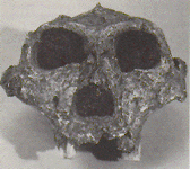
Here is the skull of Paranthropus robustus.
After Australopithecusafarensis two distinct lines are believed to have existed. One is referred to as the 'robust' australopithecine and the other is referred to as the 'gracile' form.
Another name for the robust australopithecine is Paranthropus. The paranthropus are distinguishable from the gracile by their large molars and premolars. The possession of such large teeth is supposed to have aided in powerful chewing to help digest tough plant materials.
There are believed to be three species of Paranthropus. They are named robustus, boisei, and aethiopicus. These forms are thought to have lived from about 2.4 million years ago to about 1.8 or even 1 million years ago.
Robustus is thought to have been a sturdily-built, great-jawed hominid. Robustus had massive faces with no forehead and a protruding ridge over the eye sockets.

Here is an artist's interpretation of what Paranthropus boisei would have looked like.
After Australopithecusafarensis two distinct lines are believed to have existed. One is referred to as the 'robust' australopithecine and the other is referred to as the 'gracile' form.
Another name for the robust australopithecine is Paranthropus. The paranthropus are distinguishable from the gracile by their large molars and premolars. The possession of such large teeth is supposed to have aided in powerful chewing to help digest tough plant materials.
There are believed to be three species of Paranthropus. They are named robustus, boisei, and aethiopicus. These forms are thought to have lived from about 2.4 million years ago to about 1.8 or even 1 million years ago.
Robustus is thought to have been a sturdily-built, great-jawed hominid. Robustus had massive faces with no forehead and a protruding ridge over the eye sockets. Most specimens have sagittal crests. These are bony ridges running back atop the skull where powerful chewing muscles attached. This feature suggests that this species ate mostly coarse,tough food-like nuts, hard-shelled fruits, fibrous roots and tubers. Surveys done on teeth collected from this species show that the average age at death would be about 17 years.
These australopithecine forms never
contributed to the ancestry of modern humans before their extinction.
Paranthropus
is believed to have made use of stone and bone tools.